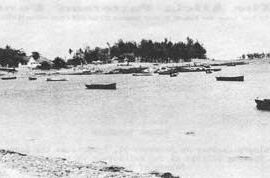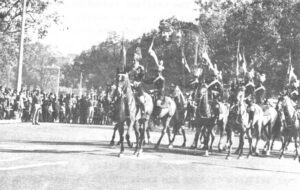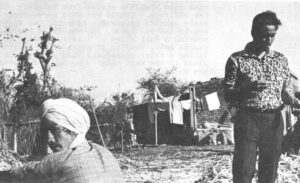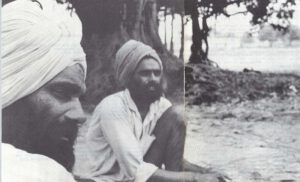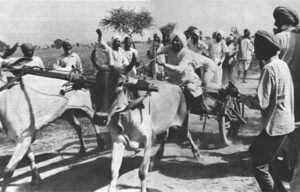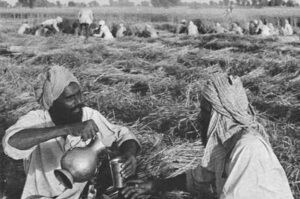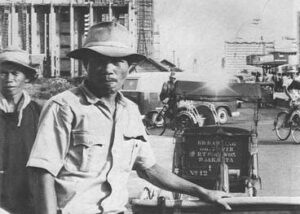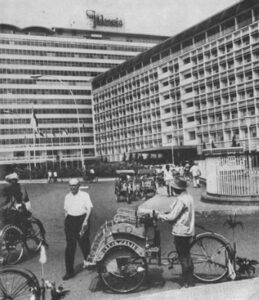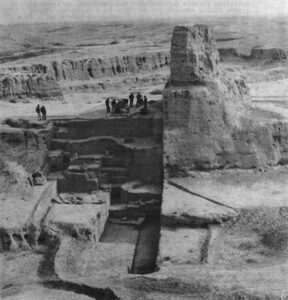1. Nobel Prize for Dr. Borlaug
2. Djakarta: The First “Closed City”
October 30, 1970
A few days ago I received a cable from the Washington Star asking me to write a story on this year’s award of the Nobel Peace Prize to Dr. Norman E. Borlaug, an associate director of the Rockefeller Foundation and the distinguished plant geneticist who did much of the pioneering research that made Asia’s present “green revolution” of new seeds and fertilizer possible. “What’s it all about?” the cable ended.
My instinctive, one-word reply to the question was “culture.” That what the green revolution was really all about was not only agricultural transformation but also very rapid cultural evolution, perhaps even upheaval, in hundreds of thousands of villages all over the world. And villages which until now had been pretty much left behind by history.
The “hundreds of thousands” gave me a little pause, since my own experience had been almost entirely limited to two villages where I have been living much of the past year: Ghungrali-Rajputan, a prosperous, wheat-producing community on northern India’s Punjab plain and Pilangsari, a relatively poor rice-growing village on the banks of the Tjimanoek River in western Java.
The two villages and the reaction of their inhabitants toward the green revolution were strikingly different. On the one hand, the robust, down-to-earth Punjabis in their traditional pursuit of the good life, were eager to modernize and mechanize and enjoy the material benefits of Western technology. And all but the elderly seemed fully prepared to pay the cultural price.
On the other hand, the mystical, artistic, highly cultured Javanese peasantry were taking to the new seeds with conspicuous reluctance, and one felt, only out of economic necessity; among several villagers the new technology was viewed, and rightly, as a direct threat to the traditional Javanese belief and behavior system with its distinctive style of life and human relationships.
It was not surprising that in Punjab the farmers themselves were taking the lead in innovation and chafing at the Indian government’s slowness to adopt to change. While in Java it was the Indonesian government which was using much of the pressure and means of persuasion at its command to get the villagers to grow the new rice.
But in both villages an almost identical economic process was taking place: there was a distinct shift away from traditional systems in which the poor landless people of the village received a fixed part of the crop in return for the labor. Instead more and more farmer-landowners were opting for simple cash payments.
This movement toward a money economy is built into the green revolution. The new seeds, whether a farmer is growing wheat, rice or maize, require much heavier inputs of water, chemical fertilizer and, in the case of rice, insecticides. Water may be provided by expanded government irrigation systems, or a privately-owned tube well, but both require a greater investment by the farmer than in the past. And the big-cash outlay, needed each sowing season, is for fertilizer. This means having a sufficient marketable surplus each harvest to raise enough cash for the next crop. Automatically anyone growing the new varieties has to think in terms of money, economy of operations (especially labor costs) and returns. And when an economic system is monetarized, it is not long before the value system begins to be monetarized too.
In a traditional village, where the social structure is based on mutual interdependence, whether between the Jat owner-farmer caste and their untouchable laborers in the Punjab, or between the modest landowners and their poorer kinsmen in Java, this tends to drastically displace human values. In Ghungrali, for instance, where the poorer two-thirds of the villagers were landless untouchables, a sense of community, harmony and security had always been preserved by the caste structure, with its carefully evolved system of mutual rights, obligations and responsibilities. In return for their labor, the untouchables were guaranteed a certain amount of the wheat crop each year and the right to freely graze their cattle. The cultural crisis, described in detail in my earlier “Sketches of the Green Revolution,” came when the Jats felt compelled by the economics of growing the new wheat to put their laborers on a cash-payment basis. The untouchables refused to accept this, a mutual boycott followed (it has since ended) and the Jats, for the first time in a thousand years, refused to let the untouchables graze cattle on their land.
In Pilangsari, a similar crisis is coming. This will be described in detail in a report next month on agricultural change and urbanization in west Java and Djakarta entitled “Hello, Mister, Where Are You Going?” But hastily sketched, much of the rice harvest in Pilangsari is now carried out under what is called the tjeblokan system, whereby a group of poor relatives or fellow villagers both plant and harvest the rice crop of an often modest landowner in return for one-sixth of the crop. Moreover, under this system, the rice is cut with a tiny razor-like instrument, the ani-ani, which is held in the palm of the hand and is slow and uneconomical. (After the back-breaking wheat harvest in the Punjab, I found it rather like gathering flowers for a bouquet). Not surprisingly, the more innovation-minded peasants in the village who are also growing the new rice, are talking of switching to harvesting with a sickle and putting their workers on a strict cash basis. Certainly, it would be more efficient and economical. It would also undermine a village social welfare system established over centuries.
Government extension workers, who visited Pilangsari when I was there, openly spoke out against the tjeblokan system in favor of cash payments. They also hoped to restrict, through non-issuance of licenses, the number of village performances of the famous Javanese wajang shadow play. Here, too, the money could be more economically used for fertilizer and insecticides. But the wajang play is more than popular village entertainment; it is the very heart of classical Javanese culture and the fount of much of its religion, philosophy and moral code.
Here then were two villages, distinctly different in race, culture and world view, yet alike in that each, after being in a solid equilibrium for centuries, was now undergoing an agricultural revolution that threatened to destroy the delicate balances, by which the village had always held together. In both, these balances rested on similar customs-the heavy weight of considerations of kinship, the responsibility of the family heads to provide food, shelter and clothing for all who labored in their fields, the tacit right of the landless to graze cattle and gather wood for fire undisturbed, the inherent obligations of mutual assistance, the practice of loans with little interest and hospitality without cost, the stability of the family.
Now all this was changing. One might say that the West had finally and twice reached into these villages during this century. First, with the modern medicine and DDT that, in the past 50 years produced a cataclysmic fall in the death rate and created a population explosion (the number of people in both villages had almost doubled in the past generation). And, second with the agricultural revolution, which is proving much more decisive culturally.
One looks for a reason why this is so. Somehow the fact of more people, even twice as many people in the villages, did not do much to alter its basic culture. Everyone was poorer than before but the old traditions survived. Instead the cultural transformation follows the transformation of agriculture.
It is, of course, the same thing that happened in Europe in the 19th century when the drive for an agricultural surplus to feed a fast-growing population led to the modernization of agriculture. But this resulted in some 35 million European migrants flooding into the United States. Even the relatively small number of American Negroes displaced by the agricultural mechanization of the South has left the United States with its greatest unsolved domestic problem.
But if Ghungrali and Pilangsari are genuinely representative, as I am convinced they are, then one can deduce that the same thing must be happening in all of the hundreds of thousands of villages where the new strains of wheat, rice and maize have been introduced. To name just some of the countries where the new seeds have already had some impact: India, Pakistan, Iran, Turkey, the Philippines, Malaysia, Burma, Indonesia, South Vietnam, Taiwan, Afghanistan, Japan, Kenya, Tunisia, Morocco, Algeria, Libya, Brazil, Mexico, Paraguay (to say nothing of Russia and China where the new wheat varieties are now being tried).
The question is: In all these villages where the new agricultural technology is being practiced, does the economic imperative operate in the same way as in Ghungrali and Pilangsari so as to snap old ties and traditions, forcing peasant-farmers to face the enormous compulsion of working out new relationships, new meanings to their lives? It is my contention that the answer is “yes” and that the ensuing cultural crisis, the vast mass exodus from the land it will produce and the shock of those who have been uprooted will face the world with a problem of such magnitude as to overshadow all others by the end of this decade.
This is not to decry the green revolution. The point must be made that the growth of population following the spread of modern medicine made the adoption of modern agricultural technology an absolute necessity for most of the poor nations. The first village of my study, Grand Gaube on the southern Indian Ocean island of Mauritius, revealed the desperation, sense of apocalypse and sheer tragedy of the situation where there is overpopulation with no possibility of an agricultural revolution. The result is what comes very close to being a true Malthusian breakdown.
As Thomas Malthus wrote in his “First Essay on Population” in 1798, “Population, when unchecked, increases in a geometrical ratio. Subsistence increases only in an arithmetical ratio…The race of plants, and the race of animals, shrink under this great restrictive law. And the race of man cannot, by any efforts of reason, escape from it. Among plants and animals its effects, are waste of seed, sickness and premature death. Among mankind, misery and vice.”
In Grand Gaube village, an extremely high rate of alcoholism, a mounting revolutionary storm and the turning of the elderly toward apocalyptic prophecy all seemed to grimly fulfill Malthus’ prediction. No, the green revolution may be opening up a convulsive new chapter for mankind but it was historically inevitable.
To find another historical parallel for what seems to be happening in countless villages all over the world one can go back much farther than 19th century Europe to the very beginnings of agriculture in the Tigris-Euphrates, Nile and Indus river valleys. The first Mesopotamian or Egyptian to dig an irrigation ditch, put the first animal into harness or use a traction plow was presumably just trying to better feed his family. But these technical innovations created new styles of life, new systems of human relationships, led to the first breakthroughs to civilized society, the eventual rise of the West and, in modern times, to the imposition of European culture and, technology on the great cities of the whole world, including those of Asia.
Historically left almost untouched these five thousand years until the green revolution began to take hold just during the last three or four years, have been most of the villages of the world, where two-thirds of the human race now lives.
In result, some 80 per cent of the populations of the poor nations are still engaged in primitive agriculture, which is the main reason why these countries are poor. In the rich, advanced countries of the West, it is something less, than 10 per cent.
It has always been clear that at some point in history this gap would begin to close. And that when it did the impact, not only agriculturally and economically but culturally and in terms of the vast migration of peoples, would be momentous.
It was with such thoughts in mind I cabled back my story to the Star:
“The immediate significance of this year’s award of the Nobel Peace Prize to Dr. Norman E. Borlaug concerns food production. That more than anyone else the little known plant breeder from Iowa can be credited with rescuing millions of the world’s people from what was not long ago a widely predicted Malthusian crisis of global proportions by 1975. [Note: One such prediction was prepared for President Lyndon B. Johnson by Walt W. Rostow and the State Department Policy Planning Council in 1964; the most exhaustive study ever made on world food and population, prepared in late 1967 by Johnson’s Science Advisory Committee, was the result. So fast have things moved since then most experts feel today that the report should be drastically revised in its plans and strategy to encourage trade in food between the poor countries and avoid a glut of wheat and rice caused by too rapid an expansion of production in developed exporting nations, such as Canada, Australia, Argentina and the United States .]
But a second dimension to Dr. Borlaug’s achievement has been as an agent of what promises to be profound, worldwide and possibly convulsive cultural change as modern western technology reaches for the first time into hundreds of thousands of remote, traditional Afro-Asian villages. In the broad sweep of history, the cultural impact his new seeds are having seems likely to overshadow his scientific contribution to agriculture alone.
“Presently an associate director of the Rockefeller Foundation in charge of wheat research at the International Maize and Wheat Improvement Center in Mexico, Borlaug has played the pioneering role the past twenty-six years in developing the new dwarfed, stiff-stemmed strains of wheat, rice and maize which in the past five years have begun to revolutionize agriculture in the poor two-thirds of the world…The history of this “green revolution” is now becoming familiar, the years of patient, pioneer research by Borlaug, Dr. J. George Harrar, the present president of the Rockefeller Foundation, and other plant breeders in the hills above Mexico City, using wheat brought, according to legend, from Spain by Cortez and crossbreeding it with dwarf strains from Japan, eventually producing a shorter, stockier plant which matured rapidly, was non-seasonal and did not lodge under its own weight when heavily fertilized. The expansion of research by the Ford and Rockefeller Foundations and, the breakthroughs in cross-pollenization of rice in the Philippines and hybrids of other food grains which quickly followed. And, former President Johnson’s tough decision, jointly based on predictions of global famine and the emergence of the new seeds, of tying future American food aid to steps by recipient countries to grow more food.
“Borlaug himself has credited the rapid success of the green revolution in India, Pakistan and Turkey to their imports of large quantities of Mexican seeds (18,000 to 40,000 tons), government polices promoting fertilizer sales and incentive prices, and the establishment of aggressive indigenous research programs. He has described the greatest achievement of the green revolution as demonstrating “that food production need not be a problem for the next three decades;” time he feels must be used to bring population growth in check.
“But recognition of Borlaug’s work and the green revolution itself comes at a time when it also is becoming increasingly evident that in every area where there has been success-where the new seeds and heavy inputs of water, chemical fertilizer and insecticides they require have succeeded in doubling or tripling harvests-a deep cultural crisis has followed…”
The story cited some examples from the Punjab and Java and then went on to make what I hoped was my main point: “It has always been obvious that if you change a village’s agricultural methods you are also going to change its cultural values. What perhaps has not been so obvious was the vast scale and scope of the Cultural Revolution which has been set off by the new seeds…”
A couple of parenthetical remarks: Dr. Borlaug is quoted as saying the green revolution now gives the world thirty years more time in which to reduce population growth rates to manageable levels, what is usually described as “a breathing space of two or three decades” by development economists.
Here it should be noted that in India many agricultural technicians, both American and Indian, challenge this and maintain India will be lucky to get two or three years before the population growth rate of 2.5 per cent and the real food demand growth rate of 3.5 per cent exceed the increases in agricultural out-put.
I myself would like to challenge the whole notion of any expectation of success in population control. There has been so much talk in the West about how the poor countries must hold their populations in check that one tends to have the vague feeling that some progress must be being made somewhere.
In both the villages where I lived, Ghungrali and Pilangsari, the incentives, both human and economic, among the landless laborers to have large families appeared to outweigh the disincentives. Unlike the world’s educated middle classes, or prosperous farmer-landowners, who have taken to family planning out of a desire to educate their children or perpetuate their farm into the future as a viable economic unit, the poor majority of the peasants appeared to have a real interest in having as many children, or as many potential wage earners in their household, as possible. With few exceptions the poorest peasants were not worried about educating children who traditionally start work as farm laborers and bread winners at the ages of 13 or 14. In both villages there was a heavy cultural emphasis on fertility and procreation and government propaganda on behalf of family planning seemed no match for the pressures on a young bride to validate her own position by having many sons, and as soon as possible. One of the Indian government’s birth control slogans is “The small family is a happy family.” In reality, in the villages, the reverse seemed true; it was the large, teeming households, with plenty of daily wage earners and the security of numbers that was the happier.
In Ghungrali, there was considerable impact from government programs promoting knowledge of birth control. A huge billboard praising the two to three-child family greeted you as you entered the village. Everyone seemed to have an awareness of the pill and intrauterine devices and the government’s catchy slogan of “Do ya teen, bas!” (“Two or three, finish!”) was as familiar as a Winston ad would be in America. In contrast, in Pilangsari, there was almost no awareness of the government’s family planning program or of either the pill or I.U.D.
Yet in practice, birth control seemed much the same in both Ghungrali and Pilangsari. The more prosperous, better-educated landowners had smaller families based on motives of enlightened self-interest and the poorer, landless laborers had big families, also in terms of their own self-interest.
In the city of Djakarta, family planning has been practiced by 15,000 women, presumably middleclass, educated, and civic-minded ladies. But Djakarta is a city of almost five million people.
It is my own impression after a year in the villages that what holds true for Djakarta holds true for the world, and that any expectation of limiting global population through government-sponsored family planning efforts for the rest of this century is totally unrealistic.
Why should a Punjabi laborer or Javanese peasant limit the number of children he has when he does not feel it is in his individual interest to do so?
One day when I was working out in the rice paddy with Husen, a Javanese farmer who has been my principal subject of study in Pilangsari, and I asked him, “Don’t you worry about the world’s population doubling by the end of the century? Think what this village would be like with twice as many people.”
“I can’t think about that. Wah, I’d go crazy,” answered Husen. So maybe I’d like to go to the moon too. I won’t even ride in a motor car before I die.” (The father of four, three of which died in childbirth or infancy, Husen hopes to keep on having children to insure the survival of at least three more).
Thus it seems inevitable there will be at least another one billion people in the poor countries alone by 1985 and that the number of those who will depend upon agriculture for their livelihoods will rise about 50 per cent. If the present green revolution follows the pattern set by the agricultural revolution in Europe in the 19th century, the greatest exodus from the land and migration to the cities in history is about to commence.
British economist Barbara Ward has said the prospect is of “a tidal wave, a Hurricane Camille of country people that threatens to overwhelm the already crowded, bursting cities. It is not so much immigration as inundation.”
For the past two years the world Food and Agriculture Organization in Rome has taken the position that the food problem of the 1960’s has become the unemployment problem of the 1970’s. The Netherlands Addeke H. Boerma, the FAO’s director general, told the second meeting of the World Food Congress in The Hague last July that unless the green revolution was carefully managed the result might be “a conflagration of violence that would sweep through millions of lives.”
In September, World Bank Director Robert S. McNamara reported to his board of governors that “the poorest quarter of the population in developing lands risks being left almost entirely behind in the vast transformation of the modern technological society.” McNamara said “the ‘marginal’ men, the wretched strugglers for survival on the fringes of farm and city, may already number more than half a billion. By 1980 they will surpass a billion, by 1990 two billion. Can we imagine any human order surviving with so gross a mass of misery piling, up at its base?”
It is hard to see how the green revolution could be carefully managed, as Dr. Boerma urges. Governments are up against the same problem as they encounter in trying to check population growth: the self interest of an individual peasant, usually a man with extremely limited horizons whose confident belief in his position in the world and his relationship with all humanity has been fixed over centuries by very old, stable, traditional village cultures.
But this has its positive aspect. When McNamara speaks of “wretched strugglers for survival,” he seems to hit a false note. “Strugglers” for survival?” Yes. “Wretched?” I would say no if one is taking in all of the half-billion “marginal” men he says there are already. I am willing to venture that most of these still strongly identify with a village and that village’s culture even if they actually have lived for years in a great Asian city as a coolie, a betjak driver or in other menial work. As long as they retain this sense of cultural identity, this sense of having a place in a universe with fixed cultural values, no matter how poor they are, I do not think they can accurately be called wretched.
And here to me is the real meaning of the green revolution: That for the past few decades the old structure of the old village society in vast stretches of Asia, Africa and Latin America has begun to crumble. The introduction of modern medicine and the population explosion that followed gave village culture a rude shock and weakened the aged foundations. The new seeds and the transformation of agriculture and the village economy they require could be the climactic blow.
All over the poor two-thirds of the world there may be a mighty cultural and economic collapse leaving without homes millions of helpless, bewildered people. There would not only be such a vast army of emigrants as the world as never seen but an army of peasants alienated from their culture. That we might be faced not only with a massive flood of people to the cities but also a wholly unprecedented phenomenon of global cultural alienation is the frightening part.
Djakarta-The First “Closed City”
Three months ago Lieutenant General Ali Sadikin, the governor of Djakarta, declared that because of the flood of incoming islanders and country people had reached “proportions endangering the safety and order of life in the capital,” Djakarta would henceforward be “a closed city to new jobless settlers.”
It was the most drastic action yet taken by a great Asian city to try and stem the flow of urbanization.
General Sadikin privately admits that his action, at least for now, has been largely for psychological impact, to try and discourage rather than physically prevent people from coming into Djakarta. (“We cannot, after all, arrest somebody for entering the nation’s capital,” he says. “We are trying to reduce the flow, we know we can’t stop it.”)
But in Bombay there has been a heated debate over how to create a workable system to actually keep all new migrants out. This has raised legal questions since the Indian Constitution provides for freedom of movement. Other Indian cities are studying Moscow’s apparently successful method of holding its population growth in check through a work certificate system. But this requires an extensive police apparatus to say nothing of the curtailment of civil liberties it implies.
All of which is evidence of the mounting desperation shared by urban planners all over Asia, Africa and Latin America as they are faced with the seemingly insurmountable task of providing water, sanitation, housing, education, transportation, law and order and, above all, jobs, to exploding urban populations.
Even if migration into the cities in the developing countries came to a complete halt, natural population increases at present rates of up to 3 per cent (Djakarta’s is 2.5 per cent) would double the number of urban dwellers by the end of the century. But migration from the countryside is not halting, it is accelerating by the rate of at least 5 per cent a year as population pressures build up in the villages and at least some landless laborers are displaced by the green revolution. So the planners’ desperation seems understandable.
On any present calculation, there will be more than 18 cities in Latin America and more than a dozen in India and Pakistan over the million mark by the end of this decade. Buenos Aires may have 9 million, Cairo 6 million, Djakarta 6 or 7 million. Calcutta, with a density of population twice that of Chicago, with 70 per cent of its families living in single rooms and countless, thousands sleeping at night on its pavements, may reach 15 million.
In many of these cities, it is only a matter of time before an actual majority of the inhabitants will be new immigrants straight from the villages, a large proportion of them without jobs and a very high proportion of them without housing, sanitation or a pure water supply.
Indeed, this appears to be already true of Djakarta. The city government admits as many as 80 per cent of its citizens may live outside its basic public services. Only 15 per cent of Djakarta’s families pay property taxes. Less than 12.5 per cent of the homes are electrified and only 15 per cent are connected to the city’s water supply. (The current capacity of Djakarta’s water purification system is 3,300 liters per second as against an estimated real demand of 8,000 liters per second. The gap is presently filled with well water, which on the northern, seaward wide of the city is brackish. The government hopes to reach an 8,000-liter capacity by 1974, when the population will have grown another half a million).
But such statistics are only warning signals of the true nature of today’s urban crisis in cities like Djakarta. In contrast to the 19thcentury experience of Europe, where the cities developed at the same time as the agricultural revolution and growth of the industrial system, cities like Djakarta lack a solid base of manufacturing jobs.
In a city which is growing at the rate of 5.6 per cent a year, the number of totally unemployed is estimated at 58,000. Of some 65 industrial development projects approved by the Indonesian government by last December, 34 involving an investment of around 4 billion rupiahs (375 rupiah equals $1) are in Djakarta itself-General Sadikin estimates these will employ about 40,000 men.
Of some 134 new projects involving $169 million in foreign investment, Sadikin estimates that, based on a formula that a million U.S. dollars of foreign investment provides jobs for 200 men, that employment for 30,000 men should be opened from this source.
This obviously represents a very high rate of capitalization per worker. In the 19th century the industrial system began with simple technologies demanding few skills and a low rate of capitalization per worker-the equivalent of six months average wages would be typical of a hundred years ago. Compare what would have been about $200 at best with Sadikin’s probably optimistic estimate of $5,000 of investment per job created in Djakarta today. A hundred years of growing technological sophistication means at least a sixty-fold increase in the capital needed and a much more intensive level of skill and trained supervision.
The industries flowing into Indonesia (45 per cent of it to Djakarta city) from foreign investment tend to be highly oriented toward capital-intensive technology-of 22 recently approved projects almost all were for electronics, machinery, communications, metal production, food processing and medicine. This is at a time when capital is extremely scarce in Indonesia and labor pitifully plentiful. Even in the unlikely event of a phenomenal expansion of industry in the next ten years, the number of unemployed in Djakarta would probably be as high as ever.
Another problem is that modern industry demands a certain size of market if necessary economies of scale are to be achieved. But the relatively modest needs of Djakarta’s small middle class sets a limit on the number of industrial jobs that can be built up by substituting local manufactures for former imports. (Going by the number of people who have pure water and electricity one can guess that the middle class of Djakarta would be around 600,000). Nor do export markets offer an easy alternative since new Indonesian industries would be up against the efficient, and long-established American, European and Japanese competitive giants.
The vast majority of the immigrants pouring into Djakarta are Javanese peasants without any industrial or urban skills (although they are among the world’s best rice farmers). Only 650 miles long and 75 miles wide, Java’s 74 million population is one of the densest in the world (the rest of Indonesia’s population, spread out over the 3,000 far-flung islands of the Indonesian archipelago, numbers only 31 million).
Most of the uprooted Javanese villagers turn to the so-called tertiary economic activities-betja pedaling, street vending, petty hawking, shining shoes, selling rice-the kind of employment which keeps a man from absolute starvation but contributes all but nothing either to the economy’s development or to his own acquisition of skills and confidence. Enough also turn to prostitution and pimping to pose what the Djakarta government terms “a serious problem.” Official statistics put the current number of prostitutes at 3,082 and pimps at 590. I would have put the number far higher.
But the real symbol of the new immigrant from the countryside in Djakarta is the betjak driver-the lean, hard-muscled peasant who earns a precarious existence pedaling one of the brightly-painted tricycles that are Djakarta’s main form of transportation. There are presently 126,000 registered betjaks in the city and General Sadikin estimates that, since most are driven on a two-man shift, there may be as many as 240,000 betjak men in all, numbering, with their families, perhaps as many as 700,000 or 800,000 people. Sadikin told me he would like to get rid of all the betjaks from Djakarta by 1980 but that, considering the need to find alternative employment for so many people, it posed a “delicate social problem.”
Sadikin has taken steps in recent months to bring the betjak men under some government control. Betjaks of different colors-yellow, blue, gray, green, red-are limited to carrying passengers in certain areas of the city and have been assigned definite parking areas. Whether the betjak drivers will ignore such attempts at regulation as serenely as they ignore traffic rules if no policemen is in sight, remains to be seen.
In recent days, the governor has also cracked down on sidewalk street vendors, who probably have outnumbered the betjak drivers. Forbidding them to set up their stalls on the sidewalks of the main streets and establishing a new licensing system, Sadikin warned that “without serious law enforcement, we can predict that streets in town within two or three years will be filled with rubbish and jammed by vendors.” He has also started a campaign against Djakarta’s legions of beggars and what he described as between 60,000 and 90,000 vagrants. These are immigrants, often from Sumatra or another islands who do nothing at all, camp in parks and railway stations and are blamed for much of the city’s petty crime. Yet like most of Djakarta’s people, these seem a cheerful lot. The most conspicuous exception to the generally buoyant spirits of the Djakartans are ragged men one sees in the streets picking up cigarette butts so that the tobacco can be reused. They tend to have a carious aloof air and seldom look about them; possibly they are too ashamed.
Operating on a limited budget, General Sadikin sometimes has had to use considerable ingenuity to keep the city running. Five years ago Djakarta had only 500 buses in running condition; commuters had to wait three or four hours and then hang from the doorway if they wanted to get anywhere. Today Djakarta seems to have one of the fastest and smoothest bus systems anywhere. (And the cheapest; you can go all over the city for about two cents. For the first time ever, this reporter became a confirmed bus rider in Djakarta).
Sadikin credits the spirit of entrepreneurship for this success. He has established a monopoly system on all the routes, hiring private contractors with a minimum of 50 buses. Unfortunately, the same thing won’t work for low-cost housing, one of Djakarta’s most serious needs. Sadikin is aware that the building trades are the largest potential users and trainers of unskilled labor (all those betjak men) and that a large building program would stimulate industry.
The problem is that even a modest middle-class house would cost 2.9 million rupiahs per unit, which most Djakartans couldn’t afford to pay back in twenty years. Without a commercial return on investment, low-cost housing is by-passed by investors in favor of building luxury tourist hotels, cinema houses or restaurants. These are, indeed, going up all over-the city.
Sadikin agrees that a big low-cost housing program in Djakarta, similar to those in Singapore, or Kuala Lumpur, might be the speediest and most effective way of creating jobs. He said what he would really like is to be able to negotiate directly a 50-year, 2 per cent housing loan from the World Bank or other international lending agency.
Which suggests some sort of international system of guarantees to local mortgage institutions possibly through a new international mortgage bank might be highly desirable in the future.
As Sadikin explained his problem, “Somebody like Lee Kuan Yew has all the power in his hands. I have to go through the central government. And in the current five year plan the Number 1 priority is agriculture.”
He said that until some way is found whereby poor people can pay back the enormous amount of capital involved in low-cost housing or some new form of foreign assistance, is provided, his city government is only capable of restoring and patching up the existing bamboo hutments or “kampongs” in the city. Last year, he spent 500 million rupiah on providing bathing facilities, sanitation, paving, health clinics, bridges and windmills for deep well water for five communities. This year the budget has been increased to a million rupiah for the improvement of 20 additional kampongs.
Experience in Djakarta has shown that squatter communities have unsuspected vitality and initiative if given even this modest form of assistance. House fronts are painted, bamboo walls plastered with old newspapers and painted white flower boxes appear, rubbish heaps vanish and a general air of hope and confidence seems to displace the old apathy.
Like many, the governor sees the greatest hope for Djakarta’s future in the green revolution and the chance the new strains of rice, together with rehabilitation of Java’s irrigation system, will make the villages prosperous enough to keep at least some of the would-be immigrants of the future back down on the farm. Certainly the critical increase in agricultural productivity which preceded industrialization in 19th century Europe is now appearing in Java and some of the other islands. And it is true that some Javanese farms, such as the one where I spent much of this Fall, would theoretically support three times as many people as at present if there is double and triple rice cropping and a sufficient water supply.
But the bulk of the evidence is on the other side. That, aside from Java’s net yearly increase of 2 million people alone, a very high percentage of the island’s rural population, perhaps as much as a fourth, will eventually be uprooted and turned into immigrants by the transformation of agriculture.
Luckily, alone of all the big countries feeling the impact of overpopulation and agricultural revolution, Indonesia has space to expand, even if the soil in the outer islands is sometimes less fertile than in Java and the rainfall less certain. So far the government-sponsored program of “transmigration” to the other islands from Java has not been a success. Indeed the flow of migrants into Java, mostly to Djakarta, has been heavier coming in then out. General Sadikin said he was recently told by the mayor of Padang in Sumatra that his city’s population had fallen the past two years from 365,000 to 307,000. The mayor reported that 48,000 of those who left Padang went to Java, mostly to Djakarta, where there is already a community of more than 400,000 West Sumatrans.
One problem where Sadikin is beginning to see light at the end of the tunnel is in education. Four years ago, there were school facilities for just 379,000 children out of 725,487. In the past three years, 157 new schools have been built and the Djakarta government, has launched what it calls a “dynamization program” to normalize the curriculum in the city’s Moslem schools in return for building 346 new ones. (The traditional Madrasa or Indonesian Moslem school has taught only the teachings of the Koran). This has enabled Sadikin and his staff to find school facilities for all but 64,000 of the city’s children and scale down the problem to what they feel is manageable proportions.
Similarly, the huge new Djati Luhur dam and hydroelectric project in western Java, with its three billion cubic, meters capacity reservoir, is hoped to solve the water problem by 1985. Currently in mid-construction is a complete renovation of Djakarta’s Dutch-built drainage system and the creation of artificial lakes to prevent the flash floods the city is subject to after heavy rains.
Oddly enough, at first appearance, Djakarta does not seem to have a population which will reach 5 million in just another month or two. Lying at the head of a deep bay sprinkled with almost a thousand tiny islands, Djakarta looks northward across the Java Sea. It used to be called Batavia, and along the canals near the port there are still a few of the old houses, with brown-tiled roofs and diamond-paned windows, built by the early Dutch colonists. Djakarta stands on what was once swampland, and the network of canals which covers the whole city area is really a system of drainage ditches; ditches in which many people, lacking any other source of water, continue to answer the call of nature, wash their bodies and launder their clothes.
When the Dutch left it 20 years ago, Djakarta had a population of about 400,000 and it seems even today less a city that a vast conglomeration of kampongs held loosely together by a network of roads.
As you drive along Djalan Thamrin, the elegant six-lane highway flanked by the famous Hotel Indonesia and a 29-story incomplete skyscraper begun by the late President Sukarno during his most extravagant days, past the towering new buildings and monuments and the big solid bungalows standing in their leafy, spacious compounds, there are few signs of overcrowding. It is only the first glimpses you get occasionally of the teeming atap and bamboo villages which encrust the canal banks or railway yards that remind you. The new slum city-with its miles of narrow lanes through densely-packed huts of bamboo or beaten tin cans, with its rubbish in the alleyways, its holes and mud, the skinny chickens picking in the dirt, the pathetically worn laundry strung up to dry and the multitudes of nearly naked children, some of them suffering from yaws and scabies-this new slum city has grown up almost hidden from sight behind the old colonial facades and impressive new glass and concrete buildings.
And in the evening, when the breathless, festering heat of the day ebbs, and twilight and the chant of evening prayers from the mosques gives way to cool tropical darkness and the murmur of voices and the stench of the canals and rubbish gives way to the fragrance of jasmine and clove-spiced kretek cigarettes, even the sour sense of poverty seems to fade away. People in clean clothes, freshly bathed, come out into the streets. Houses are festooned with lights, perhaps for a marriage or circumcision. Kerosene lamps glow from the stalls of food vendors. There is the sound of a flute or a guitar or bamboo xylophone somewhere and the ping of betjak bells as their drivers maneuver in and out of the gaps between evening strollers. And somehow the squalor and discomfort fades into the softer, warmer tones of the Javanese village. Governor Sadikin has acknowledged the importance of culture in Djakarta by building the city’s first cultural center, a large, multi-building complex that would do credit to any capital city. (He has also built Djakarta’s first beach area and downtown reaction park and says, “I want to get the people out of the slums and into the open air; 85 per cent of the people in Djakarta live in sub-standard conditions and they need not only jobs, they need entertainment”.)
It is rare to meet anyone in Djakarta who does not name a village as his real home or view his stay in the city as anything but transitory until he can save up enough money. These are people with a sure sense of cultural identity and their own place in the universe. It would be false sentiment and false reporting to say the slums of Djakarta were merely squalid or wretched. Over the centuries the Javanese have evolved a stunningly beautiful and harmonious way of life and even in the Djakarta slums, when the heat and harshness of the day gives way to evening, one is almost back in the village again. Perhaps down the street a lone guitarist looks up at the trees and the stars and sings of working in his rice fields or swimming in the river at home. Or perhaps there is a wajang shadow play, with its titanic, inconclusive struggles between good and evil and its gods, demons and hero-clowns.
Babad Tanah Djawi, the Javanese creation myth, offers its own explanation for the island’s current troubles. In it, Semar, the wonderfully wise shadow-play clown and the greatest of the Javanese culture heroes, is asked by a Hindu-Moslem priest, the first of Java’s long line of colonizers, to tell him the story of Java before there were any men.
Semar says that in those days the whole island was covered with primeval forest except for a small patch of rice fields he himself had been cultivating for ten thousand years at the foot of Mount Merabu. The priest expressed astonishment at such longevity and Semar admitted he was not a human being but the guardian spirit of Java. Then Semar asked the priest, “But why are you ruining my country? Why have you come and driven my children and grandchildren out? The spirits, overcome by your power and learning, are being forced to flee into the volcano craters and into the depths of the Southern Sea. Why are you doing this?”
“I have been ordered to fill this island with human beings,” the priest replied, “I am to clear the forest for rice fields, to set up villages and settle thousands and thousands of people. This is the will of my king and you cannot stop it.”
Received in New York on November 3, 1970.
©1970 Richard Critchfield
Mr. Richard Critchfield is an Alicia Patterson Fund award winner on leave from the Washington Evening Star, Washington, D.C. This article may be published with credit to Mrs. Critchfield, the Washington Star and the Alicia Patterson Fund.

